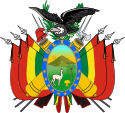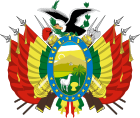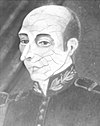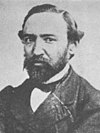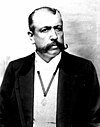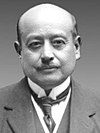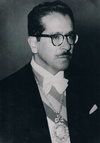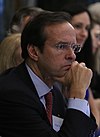
The president of Bolivia, officially known as the president of the Plurinational State of Bolivia, is head of state and head of government of Bolivia and the captain general of the Armed Forces of Bolivia.

Hernán Siles Zuazo was a Bolivian politician who served as the 46th president of Bolivia twice nonconsecutively from 1956 to 1960 and from 1982 to 1985. He also briefly served as interim president in April 1952, and as the 27th vice president of Bolivia from 1952 to 1956.

The Political Constitution of Peru is the supreme law of Peru. The current constitution, enacted on 31 December 1993, is Peru's fifth in the 20th century and replaced the 1979 Constitution. The Constitution was drafted by the Democratic Constituent Congress that was convened by President Alberto Fujimori during the Peruvian Constitutional Crisis of 1992 that followed his 1992 dissolution of Congress, was promulgated on 29 December 1993. A Democratic Constitutional Congress (CCD) was elected in 1992, and the final text was approved in a 1993 referendum. The Constitution was primarily created by Fujimori and supporters without the participation of any opposing entities.

Mamerto Urriolagoitía Harriague was a Bolivian lawyer and politician who was the 43rd president of Bolivia, from 1949 to 1951. A member of the Republican Socialist Unity Party, he had previously been the 26th vice president of Bolivia, from 1947 to 1949, under President Enrique Hertzog. Urriolagoitía's short reign was characterized by the violent suppression of the opposition, especially unionists, and he is remembered for his inflexibility. He is considered the last constitutional president of the largely oligarchic social and political order that reigned in the country until the advent of the 1952 Bolivian National Revolution.

José Miguel de Velasco Franco was a Bolivian military officer and statesman who served as the fourth president of Bolivia on four occasions: 1828, 1829, 1839–1841, and 1848. Velasco also served as the second vice president from 1829 to 1835 under Andrés de Santa Cruz, though the first two of his terms were as vice president-designate, pending Santa Cruz's arrival to the country.
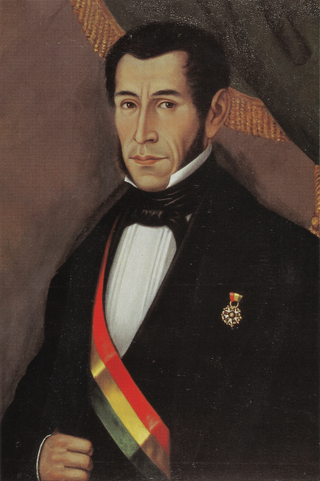
Mariano Enrique Calvo Cuéllar was a Bolivian lawyer, general and politician who served as the de facto eighth president of Bolivia briefly in 1841. He also served as the third vice president from 1835 to 1839 during which he also held the powers of acting president while President Andrés de Santa Cruz was in Peru. He would also be given the rank of general and commander of the Bolivian Army by Santa Cruz.

The following outline is provided as an overview of and topical guide to Bolivia:
Bolivia has recognised same-sex civil unions since 20 March 2023 in accordance with a ruling from the Plurinational Constitutional Court. The court ruled on 22 June 2022 that the Civil Registry Service (SERECI) was obliged to recognise civil unions for same-sex couples and urged the Legislative Assembly to pass legislation recognising same-sex unions. The court ruling went into effect upon publication on 20 March 2023. The ruling made Bolivia the seventh country in South America to recognise same-sex unions.

Bolivia has had seventeen constitutions, including the present one, since its foundation in 1825.

General elections were held in Bolivia on 29 June 1980, the third in three years. As no candidate in the presidential elections received a majority of the vote, the National Congress was required to elect a President on 6 August. With Hernán Siles Zuazo of the Democratic and Popular Union the favourite to win the Congressional ballot, the process was disrupted on 17 July by the military coup led by General Luis García Meza Tejada. However, Meza was pressured to resign on 4 August 1981, resulting in General Celso Torrelio becoming president. In July 1982 he was replaced by General Guido Vildoso, who was named by the high command to return the country to democratic rule. On 17 September 1982, during a general strike that brought the country close to civil war, the military decided to step down, to reconvene the National Congress elected in 1980, and to accept its choice of president. Accordingly, the National Congress revalidated the 1980 election results on 23 September and overwhelmingly elected Hernán Siles Zuazo as president on 5 October. He subsequently assumed the presidency on 10 October 1982.
The Supreme Court of Justice is the highest court of ordinary jurisdiction in Bolivia, based in Sucre. Its powers are set out in Articles 181–185 of the 2009 Constitution and the Law of the Judicial Organ. It was first seated on 2 January 2012.
Bolivia has experienced more than 190 coups d'état and revolutions since its independence was declared in 1825. Since 1950, Bolivia has seen the most coups of any other country. The last known attempt was in 1984, two years after the country's transition to democracy in 1982.
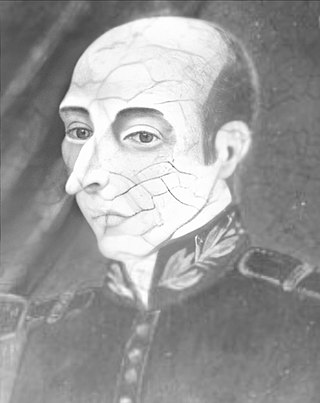
José Ramón de Loayza Pacheco was a Bolivian general and politician who served as the first vice president of Bolivia from 1828 to 1829. He was elected by the Constituent Assembly on 18 December 1828 and served as acting president in the absence of Pedro Blanco Soto until 26 December. Loayza served as provisional vice president for only six days until his arrest and the termination of his mandate on 1 January 1829.
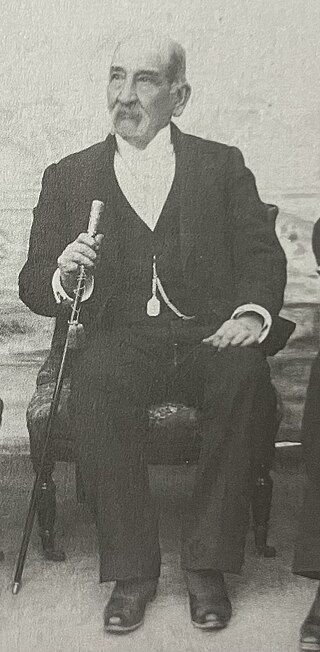
Serapio Reyes Ortiz was a Bolivian lawyer, professor, and politician who served as acting President of Bolivia in 1879, after the death of Pedro José de Guerra and the continued absence of Hilarión Daza, and as the ninth Vice president of Bolivia from 1888 to 1892. A member of the Conservative Party, he served as second vice president alongside first vice president José Manuel del Carpio during the administration of Aniceto Arce.

Gualberto Villarroel assumed office as the 39th President of Bolivia on 20 December 1943, and his term was violently cut short by his death on 21 July 1946. A colonel during the Chaco War, Villarroel and the Reason for the Fatherland (RADEPA) military lodge joined the fledgling Revolutionary Nationalist Movement (MNR) to overthrow President Enrique Peñaranda in a coup d'état.

José Miguel de Velasco assumed offices as the 4th President of Bolivia on 12 August 1828. Due to the tumultuous events of the time, the original cabinet formed by Velasco on 12 August 1828 continued to function until 24 May 1829, spanning the entire six day presidency of Pedro Blanco Soto and the two nonconsecutive terms of Velasco which preceded and succeeded him.
Events in the year 1828 in Bolivia.
Events in the year 1829 in Bolivia.
